Iranian retaliatory missile strikes following the killing of Qassem Soleimani were likely a way for Iran to bide its time as it plans to take revenge in a way that better serves its interests, writes Daniel Byman. This article first appeared in Slate.
Iran’s initial retaliation for the U.S. killing of Qassem Soleimani seems, for now, limited to a missile attack on two Iraqi bases that housed U.S. forces on Wednesday. The missiles killed no one, but Iran’s Ayatollah Ali Khamenei proclaimed them a “slap in the face” for the United States. Iran’s actions and rhetoric are widely seen as a way for Iran to save face domestically while avoiding actions that would lead to a military spiral. President Donald Trump, for his part, declared that Iran is “standing down” and signaled that the United States had no desire for further military escalation.
Let’s hope the crisis is over, but there’s good reason to fear it’s not. Iranian leaders may bide their time, seeking to serve their revenge cold and ensure that the ultimate response is more bloody and better serves their interests. Even if Iran currently plans not to escalate, further U.S. action or changes in the region might lead it to target the United State again.
How might Iran respond the next time?
Although we know little about the specific deliberations occurring in Tehran now, the Islamic Republic has a long record of using terrorism and attacking its enemies. Among many such operations in the regime’s 40-year history, Iran has conducted, supported, or attempted attacks on U.S. military facilities in Lebanon and Saudi Arabia, the U.S. Embassy in Lebanon, the Israeli Embassy in Buenos Aires and a cultural center there, transportation and other targets in Paris, and the Saudi ambassador to the United States (which would have killed American civilians in the blast zone), as well as numerous attacks on U.S. troops in Iraq and Israeli soldiers in Lebanon. Some of these attacks were perpetrated by or with Iran’s closest proxy, the Lebanese Hezbollah.
None of these past operations is necessarily analogous to today, particularly given Soleimani’s considerable stature and the political pressure this has created to respond strongly, but together they give us some sense of Iran’s calculus. The factors that shape Iran’s decision-making when it comes to planning attacks tend to include the symbolic value of the destruction, a desire for revenge for an iconic figure close to Iran’s senior leaders, a degree of personalization, and the practicality of the operations. As the relatively restrained missile attacks on U.S. bases show, Tehran has to balance all this with the risk of escalation. Although Iran’s ability to use terrorism is formidable, it is militarily and politically weak compared with the United States, and it must worry that a further back-and-forth could lead to the destruction of its military facilities, economic infrastructure, and other targets — indeed, Trump has even threatened to attack Iranian cultural sites.
For now, the most obvious location of an attack is another strike on a U.S. base or other official facility in Iraq. Here, the Iranians are on their home turf. The Islamic Revolutionary Guard Corps has spent years building its networks, creating and strengthening proxies, and deploying its own assets. The relative ease with which Iran was able to strike the two bases earlier this week suggests how extensive Iran’s presence is. Given that the Soleimani killing happened in Iraq and that the United States is also targeting Iran’s local proxies there, there is a symmetry to such an attack from Iran’s point of view, and the risk of escalation—while quite real—is lower than with many alternative targets.
Iran for years backed “special groups” in Iraq that attacked U.S. forces, recognizing that while the Bush and then Obama administrations might push back, they would not do so outside the Iraqi arena. The United States, of course, recognizes the risk of such an attack and is now deploying more troops to Iraq as well as to other Middle Eastern countries. In addition, Iraq may be in the process of expelling American troops, a huge win for Iran strategically and one it can claim occurred because of the criminal actions of America and because the United States feared the Iranian response.
In addition, the U.S. has bases and other facilities throughout the region. This would mean expanding the fight outside Iraq, but Tehran may find it easier to strike in a place with fewer defenses, and keeping the fight focused on military targets reduces concerns about being blamed for killing innocents. Iran has a large presence in Syria, and the U.S. forces there could be a possible target as well as U.S. bases and soldiers in Afghanistan and Bahrain, both of which are close to Tehran and where Iran has networks. Trump’s repeatedly stated willingness to withdraw from Syria might be another incentive, as Tehran may believe that an attack might lead the United States to depart once and for all. Hezbollah has repeatedly proved it can attack U.S. targets in Lebanon, but it is on the cusp of brokering the most pro-Hezbollah government in Lebanon’s history with a hand-picked prime minister. Creating a crisis could jeopardize this win for Iran’s closest client.
Because U.S. forces in the region are on high alert, and because Iran may want to send a sharper message, attacks on U.S. facilities or citizens worldwide are also possibilities. Tehran truly has a global terrorist network, and practicality may dictate going after a less-prepared post in Asia, Latin America, or otherwise far afield from the Middle East. In the post-9/11 era, however, U.S. embassies and other facilities are usually well-guarded. Tehran might consider attacking housing or commercial facilities associated with the United States and killing the Americans who live, shop, or enjoy themselves there—a less impressive achievement, but one that is far easier. Iran might also sponsor attacks on Americans civilians in Europe or other areas outside of the Middle East, as it did when a Hezbollah suicide bomber struck a bus of Israeli tourists in Bulgaria in 2012, killing five in an apparent retaliation for Israeli assassinations of Iranian nuclear scientists. Such an attack, however, would clearly be an escalation and risks an even stronger U.S. response. In addition, it would anger the host country, and Iran would risk its assets there. In Europe, for example, Iran’s leaders might worry that European leaders would be less likely to defy the United States on sanctions relief.
Iran might also try to widen the war, with Israel in particular being a possible target given its popularity as an enemy. Israel and Iran have long engaged in a shadow war, and Israel is on high alert after Soleimani’s killing. In addition, Iran can draw on the formidable forces of the Lebanese Hezbollah, which has long fought Israel and is looking to restore some of the credibility it lost in the region by backing the Syrian regime in its brutal campaign against the Sunni Muslim–dominated opposition in that country’s civil war. Israel, however, is a sideshow, and the symbolic linkage to U.S. attacks and revenge aspects are not clear. Israel would also respond fiercely against Hezbollah, and neither the group nor Iran would be eager to risk the inevitable losses this would entail.
Attacking Saudi Arabia, the United Arab Emirates, or other Gulf allies is another way to widen the war, and Iran’s 2019 missile strike on Saudi Arabia’s oil facilities shows just how real this risk is. These targets also lack the revenge quality and would not have the popularity of attacking Israel, but they are relatively easy to hit and a way to grab world attention, and the Gulf states’ ability to retaliate on their own is limited.
Iran may also try to assassinate a high-profile U.S. figure, justifying it as a proportionate tit-for-tat response. Iran’s proxy Hezbollah, for example, sought to kill Israel’s Chief of Staff Gabi Ashkenazi in retaliation for Israel’s killing of Imad Mughniyeh, Hezbollah’s longtime operational commander, in 2008. U.S. military leaders in the region or in other theaters such as Europe or Africa might be targeted as could other U.S. security officials.
Cyberattacks are another possibility. Iran has demonstrated an ability to attack critical infrastructure as well as industrial systems. Such operations, however, lack the visceral revenge quality that Iran may seek, and Iran’s demonstrated capabilities are, for now at least, not that sophisticated. Limited cyberattacks may still be part of the overall Iranian response, but they are less likely to be the tip of the spear.
For some attacks, Iran might also want to use new means such as a drone. In 2013, Iran added a new Reaper-size drone (the Fotros, or “Fallen Angel”) to its arsenal. Although Iran would need nearby basing and to overcome any air defenses, the unusual nature of such an attack may offer some advantages. In addition, the symbolism is attractive because a drone was used to kill Soleimani.
Tehran also tends to personalize conflicts, and Iran analyst Suzanne Maloney argues that it might target a Trump property in order to bring the war home to him. Given the president’s many properties that bear his name, the possibilities are quite vast. Here the victims would be pure civilians, however, and the president too tends to personalize things, creating a high risk of escalation.
Finally, Iran could attack the U.S. homeland. Historically, even when relations between Iran and the United States were at their worst, Tehran refrained from attacks on U.S. soil, recognizing the escalatory risk. The Soleimani killing, however, is a tremendous provocation, and the rules of the past do not necessarily apply. The 2011 plot against the Saudi ambassador also suggests Iran could attack in the United States. However, the plot itself was amateurish, suggesting Iran’s assets in the United States are limited, though it is difficult to make that judgment with any degree of certainty.
The Trump administration needs to think through how it would respond to the above and other scenarios. The Soleimani killing and its aftermath showed an administration confused, divided, and unprepared, leading to a further loss of confidence among U.S. allies at a critical juncture. Ideally, the United States would make clear to Iran the cost of more bloodshed and get U.S. allies to support the declared U.S. positions. This requires a sustained commitment to allied security, as Tehran’s responses may take months or even years to unfold, and it may involve a back-and-forth that involves many countries.
If the United States blithely assumes deterrence will work and does not lay the diplomatic as well as military groundwork for its next steps, Washington may find itself under pressure to lash out blindly after another Iranian strike, further setting back the U.S. position in the Middle East and giving Iran the upper hand.

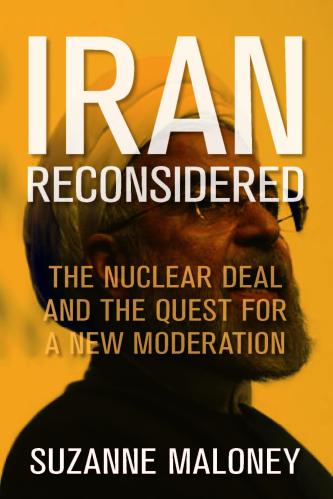
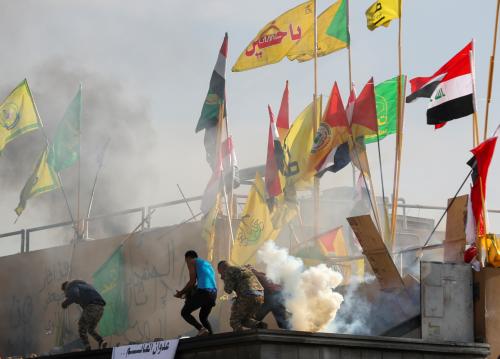
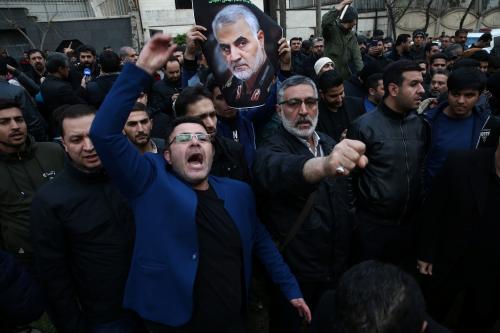
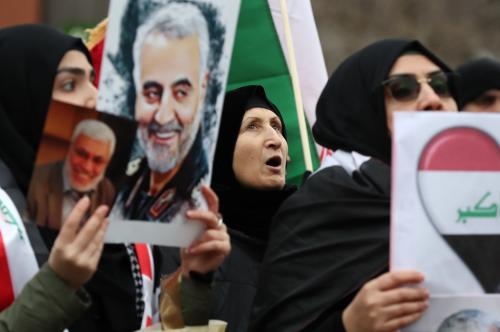

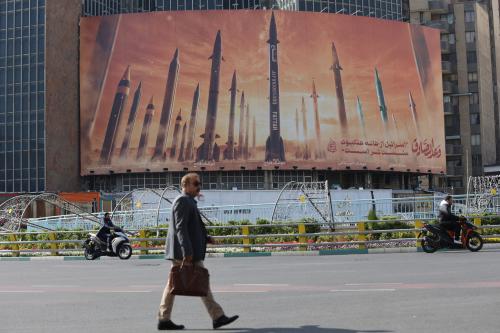
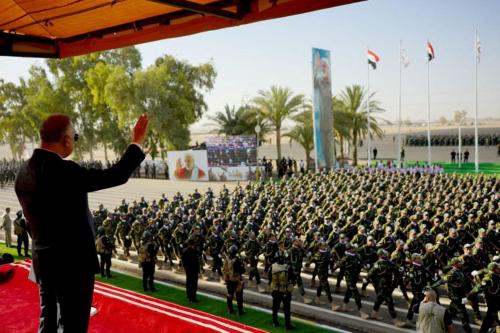
Commentary
Iran’s next move
January 10, 2020